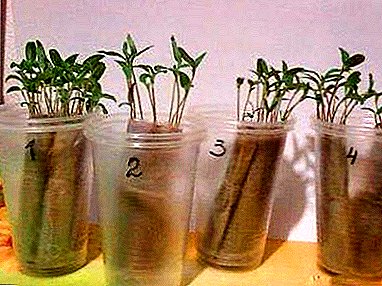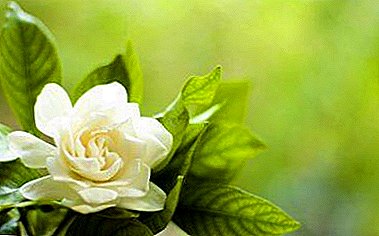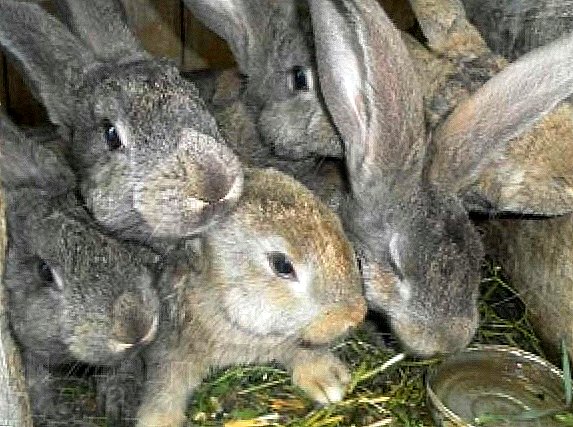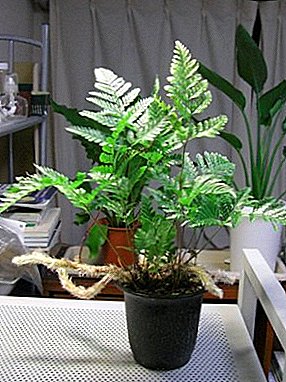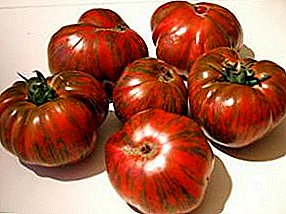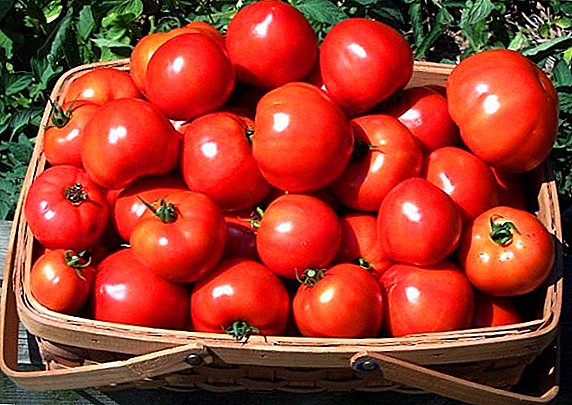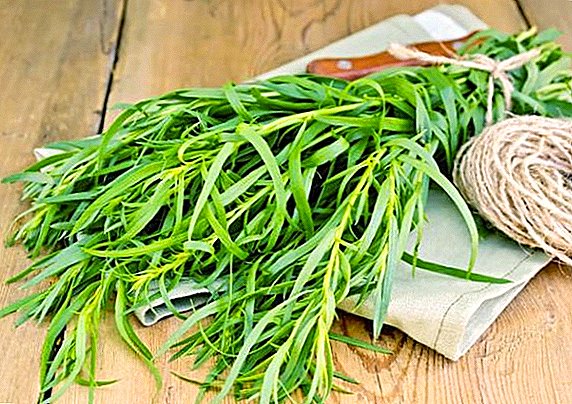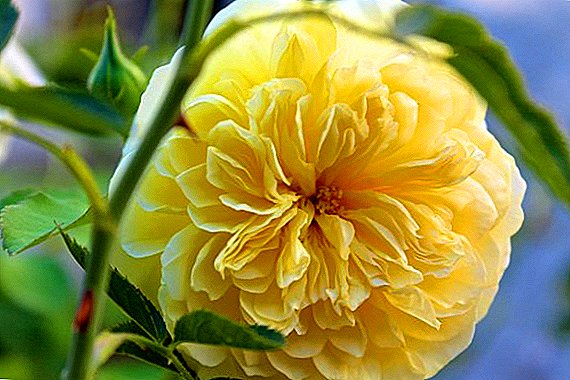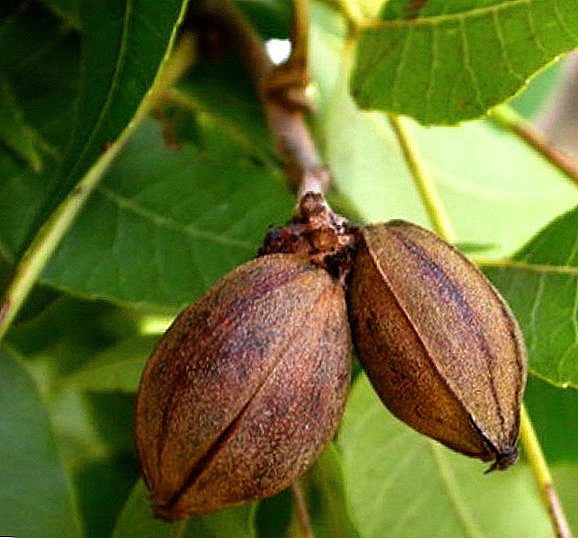 Most likely, many have heard that the pecan fruit is very useful, so the fact that such a tree can be planted in your summer cottage, and even collect considerable crops, will delight many. Immediately it should be noted that you have to stock up on strength and patience, since planting and caring for an exotic nut is not an easy task. Let's look at everything in order.
Most likely, many have heard that the pecan fruit is very useful, so the fact that such a tree can be planted in your summer cottage, and even collect considerable crops, will delight many. Immediately it should be noted that you have to stock up on strength and patience, since planting and caring for an exotic nut is not an easy task. Let's look at everything in order.
Botanical description
This plant belongs to the genus Hickory and the Walnut family. Its maximum height is 60 m. The tree has a wide spreading crown, whose diameter reaches 40 m. Its trunk is even, covered with gray-brown bark.  Branches are brown, initially have pubescence, then become smooth. On them are large, glossy leaves of bright green color.
Branches are brown, initially have pubescence, then become smooth. On them are large, glossy leaves of bright green color.
Pecan flowers can be male or female, and the pollination process takes place with the help of wind and insects. The flowering period occurs in May - June, but may shift depending on climatic conditions and in the northern regions begin in June and end in July.
Important! The pecan's average lifespan is about 400 years.
Spread
North America is considered to be the birthplace of pecan. It is grown commercially in the southeastern United States and in Central Asia. Also, the plant can be found in Kazakhstan and the Caucasus. Very rarely, but still you can see them on the Crimean peninsula.
The difference between pecans and walnuts
These two plants have a lot in common, and at first glance it may even seem that they are identical, but this is not quite so. Walnuts are not as capricious as pecans, do not require constant care and reverent attitude after planting.
Despite the external similarity, the fruits of these plants have different taste, pecan is much sweeter and more tender in texture, and for this is very much appreciated in cooking.  Fruits of walnut and pecan (from left to right)
Fruits of walnut and pecan (from left to right)
Did you know? Regular use of the nuts of this tree can tone the body, and is also an excellent prevention of cardiovascular diseases and oncological formations.
They are also famous for a richer content of useful substances. Pecan nuts are almost perfect shape, they look very neat and have no streaks, and they also have a softer skin. The difference in the price of these fruits, walnuts are 3-4 times cheaper than their overseas relative.
Pecan Cultivation
There are more than 150 pecan varieties, of which only a few are suitable for planting on the territory of Russia, namely, the Green River, Stewart, Indiana, Success, Major and Texts varieties.  In order to succeed and get the desired crop, you will need to explore some of the features and preferences of this plant.
In order to succeed and get the desired crop, you will need to explore some of the features and preferences of this plant.
Read also about growing: cashew, walnut, Manchu, black and gray walnut.
Choice of location and lighting
For this tree you need to select the lightest and the sun's little corner in your garden. It is desirable that it be protected from wind and drafts.
Of course, regions with a mild climate, in which there is a warm or even hot summer, are a priority for planting, but experienced gardeners say that even a short heat for 2-3 months is more than enough for this nut to grow successfully.
Important! In order for pecans to be fruitful regularly and abundantly, it is necessary to plant at least two such trees in the garden plot.
When choosing a place to plant, it is worth remembering that the tree grows to an impressive size, and it will require a lot of space.
Soil and substrate
Pecans need to be planted in a well-drained, fertile soil. If the soil is not sufficiently nutritious, the chances of successfully growing this plant are reduced to zero.  Experts recommend preparing a place for planting in advance and saturate the soil with compost and humus at least six months before the intended planting.
Experts recommend preparing a place for planting in advance and saturate the soil with compost and humus at least six months before the intended planting.
We advise you to read how to prepare compost with your own hands and in garbage bags, how to build a compost pit, and how to improve soil fertility.
The soil should not be too acidic, and if there is a problem with high acidity of the soil, it can be easily corrected with lime.
Planting and breeding
Pecan is bred in three ways: seeds, seedlings and grafting.
Seed propagated pecan fruitThose that fell on the ground are collected and either planted immediately, that is, in the fall, or they leave planting material until spring. The autumn period is considered to be more favorable, since during the winter the seeds are absorbed in the soil, and shoots appear in the spring.  In order to plant pecans at this time, it is enough just to dig holes 10–15 cm deep, place the planting material there, cover it with soil, water well and put mulch on top. Already in spring you will be able to watch the sprouts of future trees.
In order to plant pecans at this time, it is enough just to dig holes 10–15 cm deep, place the planting material there, cover it with soil, water well and put mulch on top. Already in spring you will be able to watch the sprouts of future trees.
We recommend you read why you need soil mulching.
Landing in the spring involves a number of preparatory work. First, you need to prepare the seeds themselves. They are recommended to be soaked for 48 hours in water, and then placed in a container with wet sawdust and stored in a cool room for 40-60 days.
As the sawdust dries, watering should be done. 2-3 weeks before planting, the container is put into a warm room. Planted seeds are planted in late April - early May. It is necessary to prepare the soil for planting, for this autumn it is desirable to add compost to it.
Video: Pecan Seed Stratification Experienced gardeners recommend planting 10-15 nuts at once, as seedlings will produce less than half of them.
When planting seeds, pecans begin to harvest no earlier than 10 years later.
Important! Pecans grow very slowly, it is necessary to transplant seedlings to a permanent place no earlier than after 3 years.
If you do not want to spend so much time and independently grow seeds, it may be appropriate another way of breeding - buying seedlings. First of all, it should be of good quality, and should be bought only from trusted vendors.
The most important thing is that the seedling must have a strong root system, which means that it must be at least 3 years old.
The disadvantages of such a planting include the fact that pecan roots are very vulnerable to damage, and the slightest error in transplantation may lead to the death of the plant.
Before planting seedlings, it is necessary to prepare pits with a depth of 50-60 cm, carefully place the plant in them, straighten the roots, and then gradually fill it with soil and water it abundantly. The final stage of planting is mulching pristvolnoy circle foliage, sawdust, pine needles or humus.
Seedlings are planted at a distance of 15-20 cm from each other.  The disadvantages of such a planting include the fact that pecan roots are very vulnerable to damage, and the slightest error in transplantation may lead to the death of the plant.
The disadvantages of such a planting include the fact that pecan roots are very vulnerable to damage, and the slightest error in transplantation may lead to the death of the plant.
Also, for propagation of this tree, an inoculation is used., but this requires a stock, namely white pecan. In this case, the plant begins to bear fruit after 4-5 years.
Did you know? Old pecan trees are capable of producing 200-250 kg of fruit annually.
Watering and moisture
Young trees need regular water procedures, special attention should be paid to the soil moisture in hot weather. This does not mean that they need to be poured, the stagnation of moisture is as harmful for the plant as the drought. Therefore, it is important to drain the soil well before planting.
Pruning and dressing
Pecan needs regular pruning and crown formation, especially at a young age. For this, sanitary pruning is carried out in the spring, which includes the removal of dried, broken and frozen branches.
Fertilize these nuts twice a season, namely in the spring and autumn. In the first case, nitrogen supplements are applied, and in the fall - potash and phosphate.  Trees that are already more than 15 years old should not be ignored either, potash salt, saltpeter and superphosphate are suitable for them.
Trees that are already more than 15 years old should not be ignored either, potash salt, saltpeter and superphosphate are suitable for them.
Wintering
Given that there is a large selection of varieties of these trees, the preference for planting in our latitudes should be given to frost-resistant. In any case, young animals must be covered with spruce leaves or polyethylene for the first 3 years after planting in order to protect not only from frost, but also from heavy precipitation.
Diseases and pests
Despite the fact that the plant is exotic and quite capricious in the care, it is completely not susceptible to pests and diseases. The only problem that can occur is a fungus on the bark.
Did you know? In Russia, the first pecans appeared in Sochi, at the beginning of the 20th century an alley of these trees was planted there. A little later they appeared in Adler, and then in many other regions.
Fungal mold occurs due to prolonged dampness or lack of sun. Fighting a disease is not at all difficult; it is allowed to use chemicals, as well as various folk remedies, for example, a solution of vinegar, ammonia or soda.
Harvesting and storage of raw materials
Fruits are considered ripe after they begin to fall. Fallen nuts are best collected immediately, rather than postponed until later, as birds and animals can readily eat them.  After collecting the nuts, you need to decompose in the fresh air and dry thoroughly for 5-10 days.
After collecting the nuts, you need to decompose in the fresh air and dry thoroughly for 5-10 days.
Then pecans can be stored in the freezer directly in the shell, this method will preserve the beneficial properties of the fruit for 2 years. You can also put in the freezer and peeled nuts, just need to consider that they will be stored much less, just 6 months.
Nuts - an important component of any proper and healthy diet. Find out what are useful: walnuts for men and women, Brazil nuts, Manchurian nuts, pine nuts, cashews, hazelnuts, almonds, peanuts, pistachios, black nuts, macadamia nuts and nutmegs.
Unpeeled and peeled nuts can be stored in the refrigerator or cellar. In the shell, they will retain their benefits during the year, but it is better to eat the refined grains in the next 2 months, because after this time, they will lose their beneficial properties.
Now you know that if you make a little effort, these beautiful powerful trees with tasty and healthy fruits can be grown far beyond their homeland. The main thing is to patiently and persistently approach this process, and everything will certainly work out.


